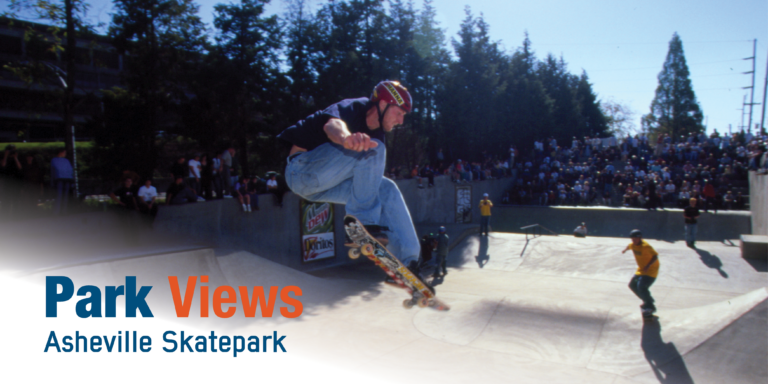This entry is part of Park Views, an Asheville Parks & Recreation series that explores the history of the city’s public parks and community centers – and the mountain spirit that helped make them the unique spaces they are today. Read more from the series.
As Asheville’s oldest parks turned 100 years-old in the late-1990s, grassroots efforts and a growing sense that safe places to have fun shouldn’t be limited to playgrounds, community centers, ball fields, and tennis courts led to the city’s first greenway, an outdoor skating rink in Carrier Park, and North Carolina’s first public concrete skatepark. The latter is an excellent example of turning a perceived problem into one of Asheville’s most valued public spaces.
Toy to Sport to Lifestyle
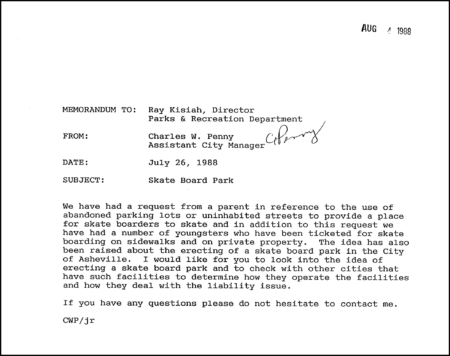 Skateboarding can be traced to the 1950s with surfers in California and Hawaii attached wheels to short surfboards, transferring the feeling of riding waves onto streets. As “asphalt surfing” became more popular, Roller Derby released the first mass-produced skateboard. It featured improved handling, leading users to develop new tricks and maneuvers.
Skateboarding can be traced to the 1950s with surfers in California and Hawaii attached wheels to short surfboards, transferring the feeling of riding waves onto streets. As “asphalt surfing” became more popular, Roller Derby released the first mass-produced skateboard. It featured improved handling, leading users to develop new tricks and maneuvers.
Skateboards evolved from toys to sports equipment as early innovators refined boards and companies like Vans developed skateboarding footwear. Skate competitions allowed boarders to showcase skills in disciplines like slalom and freestyle. During the 1960s, early skateparks opened with street courses and ramps made of concrete and plywood. Though they’re considered “old school” by today’s standards, many featured bowls modeled after empty swimming pools.
The invention of urethane wheels in 1972 made riding smoother, faster, and more comfortable. During the decade, new municipal skateparks emerged with elements such as vertical ramps and kickers. Different riders brought individual styles and tricks, developing new hardware. Shapes changed and boards became wider and more concave with a nose and tail.
As skateboarding grew in the 1980s, it became possible to make a career as a professional skateboarder. ESPN’s X Games brought skateboarding to a new level of mainstream awareness in the mid-1990s.
Skateboarding on the Top of the Civic Center
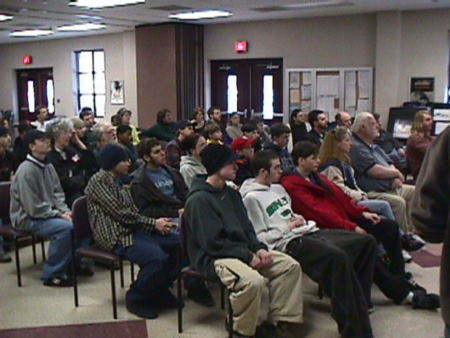 Greenville Recreation and Parks erected North Carolina’s first public skatepark in the 1980s, but it was disassembled within a year because of liability concerns. That may have stymied Asheville Parks & Recreation (APR) from building a local park, but public conversations around skateboarding in Asheville appear prevalent since at least that decade.
Greenville Recreation and Parks erected North Carolina’s first public skatepark in the 1980s, but it was disassembled within a year because of liability concerns. That may have stymied Asheville Parks & Recreation (APR) from building a local park, but public conversations around skateboarding in Asheville appear prevalent since at least that decade.
Memos from Asheville City Schools and downtown business owners to Asheville Police Department alternate between granting permission to use empty parking lots for skateboarding with complaints of damage to curbs, railings, and steps. APR began reaching out to communities that operated public skateparks for advice in 1990, though correspondence from the City of Asheville’s insurer called skateparks “an extremely poor risk with losses frequent and severe.”
It’s not clear from meeting notes if a public skatepark was meant to be a place for building skills or a centralized area to keep an eye on perceived “hooligans.” Though it never seemed well-liked by anyone, closing certain streets around the city on the weekends for skateboarding was repeatedly proposed as a short-term solution. Skateboarding remained illegal on most private property and sidewalks and streets of downtown Asheville as the sport grew, especially among young residents.
In March 1997, a public meeting brought together those who considered skateboarding to be a nuisance and others looking for a place to safely and legally skate. APR notes members of the skateboard community were “very cooperative and wanted to be part of 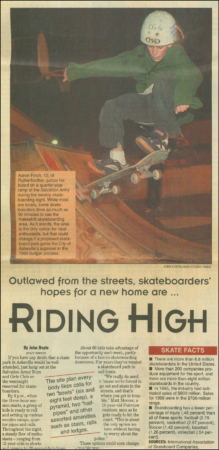 the solution if someone would just listen to them,” so a task force formed to explore temporary and permanent locations for a public skatepark in downtown.
the solution if someone would just listen to them,” so a task force formed to explore temporary and permanent locations for a public skatepark in downtown.
The task force started work immediately, collecting signatures for a petition during that summer’s Bele Chere. The lower lot of Stephens-Lee Community Center emerged as an early favorite among locations, along with the leaf dump on Broadway and a gravel parking lot at the corner of Rankin Avenue and Hiawassee Street. Stephens-Lee was eliminated as a candidate when neighbors said they felt alienated from the discussion.
A full day of skateboarding with professional demonstrations was held in City/County Plaza (now part of Pack Square Park) just a year after the task force was established and members presented a proposal to City Council on June 2, 1998. With some business owners and community members adamant that a skateboard park would bring drugs, loud music, and other problems, Asheville Parking Services suggested the top of the Civic Center parking deck – eight stories high – as a temporary location until a permanent site was found. Crucial to its unanimous approval, several seniors living in nearby Vanderbilt Apartments spoke in favor of giving the plan a chance – as did APR, police, parents, business owners, and the City Attorney.
Speed Wobble to Success
Once approved, the plan hit a snag. The temporary park’s proposed wooden ramps violated fire code. Following meetings with Asheville Fire Department, APR agreed to cover the ramps daily with flame retardant spray. With assistance of volunteers from the skateboard community, ramps, rails, and jumps were completed in time for the park to open on August 15, 1998, complete with picnic tables and bleachers. Only skateboards were allowed; bikes and skates were prohibited.
With the temporary location, skaters were able to demonstrate real-life effects of a public skatepark, calming complaints and securing a $100,000 anonymous donation for a permanent park. By 1999, North Carolina Department of Transportation (NCDOT) and City of Asheville were in talks to build the new park on NCDOT property at the corner of Cherry and Flint streets. That fall, John Fisher Architects and Team Pain were selected as the park’s designers using conceptual drawings created by the task force. Construction began in 2000 when Asheville Public Works installed storm drainage.
Committed to using as few tax dollars as possible, APR secured Food Lion as the skatepark’s naming sponsor for $275,000 in early 2001, just as retaining walls were installed. Under the agreement, the park would be named Food Lion Skatepark for its first ten years with Mountain Dew and Doritos branding prominent throughout the park.
Hundreds from throughout the region stood shoulder-to-shoulder when the skatepark opened on October 20, 2001, the same day as the grand opening of Asheville’s first public dog park in French Broad River Park. In addition to a variety of ramps, pipes, curbs, rails, and jumps, Asheville Skatepark had three distinct areas: beginners’ bowl, street course for intermediate and advanced skaters, and deep bowl to challenge the most skilled skaters. A small office and concession stand shared the upper plaza with spectator seating, restrooms, and bike racks. After a weekend of free access, daily entry was $2 for Asheville residents and $4 for those who lived outside of city limits.
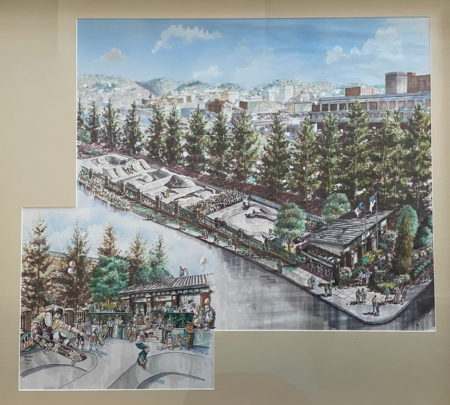
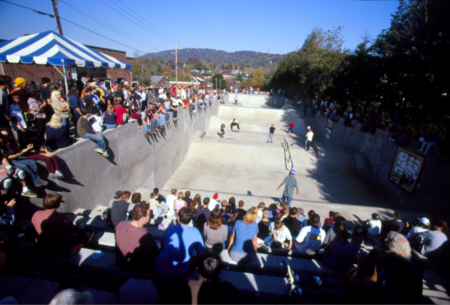
Catching Air Again
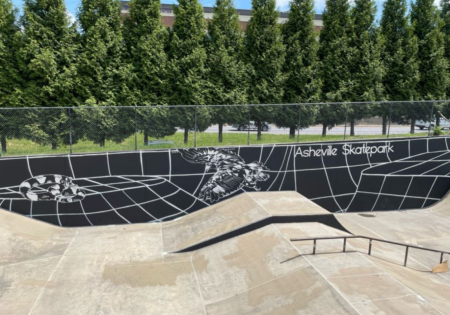 Classes, camps, and events such as Food Lion Grand Prix series, Bele Chere Blowout, Summer Slam, Halloween Bash, and Mountain Sports Festival helped build Asheville Skatepark’s early reputation as one of the best public skateparks in the southeastern United States. However, following damages in 2014, the office was no longer staffed. It was ultimately demolished to create more skateable space in 2020. As with many community investment projects, that change sparked a larger conversation within the community about the future of Asheville Skatepark, which had not seen significant upgrades since it was built.
Classes, camps, and events such as Food Lion Grand Prix series, Bele Chere Blowout, Summer Slam, Halloween Bash, and Mountain Sports Festival helped build Asheville Skatepark’s early reputation as one of the best public skateparks in the southeastern United States. However, following damages in 2014, the office was no longer staffed. It was ultimately demolished to create more skateable space in 2020. As with many community investment projects, that change sparked a larger conversation within the community about the future of Asheville Skatepark, which had not seen significant upgrades since it was built.
In March 2021, APR staff began meeting with skateboarders, roller skaters, bikers, skate shop owners, and the nonprofit Asheville Skate Foundation to discuss reimagining the space and adding new ramps in the open plaza where the office building had been located. Ultimately, everyone’s desire for a safer, updated Asheville Skatepark welcoming to families, new skaters and bikers, veteran users, and community members who want to watch homegrown talent led to $200,000 community investment by APR to modernize the park. In addition to updating the concrete landscape, the much-loved space also received new wall murals to add stylistic distinction and reflect local skate culture.
While modern skateboarding started in empty swimming pools and drainage beds, local skateboarders have a fierce sense of ownership of Asheville Skatepark, shaping its creation and guiding its future. A testament to community-driven investments, 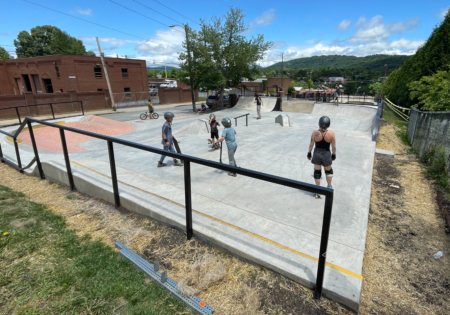 visitors to the park witness the collective skateboarding, roller skating, and BMX biking community acting as a family with advanced users mentoring newbies and giving them tips to help develop their talents.
visitors to the park witness the collective skateboarding, roller skating, and BMX biking community acting as a family with advanced users mentoring newbies and giving them tips to help develop their talents.
Do you have photos or stories to share about Asheville Skatepark? Please send them to cbubenik@ashevillenc.gov so APR can be inspired by the past as we plan our future. Sign up for APR’s monthly newsletter and follow APR on Facebook and Instagram for additional photos, upcoming events, and opportunities.
Photo and Image Credits
- Asheville Skatepark’s grand opening was a well-attended event featuring pro boarders and local talent.
- The earliest mention of a dedicated space for skateboarding in the APR archives is from 1988.
- Ashevillians on both sides of the debate packed a public meeting tin 1997 that led to formation of a skatepark task force. This picture is from a later design session with Tim Payne of Team Pain.
- APR wasn’t the only organization working with the skateboarding community. Other nonprofits provided temporary areas for local boarders, as pointed out in this newspaper article.
- An artist’s stylized rendering of an aerial view of the park and detail of the plaza adds more landscaping and eliminates Cherry and Flint Streets while hiding I-240.
- Asheville Skatepark’s unique location takes advantage of its urban setting with views of the mountains, seen here on opening day.
- Asheville Skate Foundation and APR collaborated with artists in the skate community to add murals to the park in 2023.
- No longer a space exclusive to skateboarding, the reinvisioned upper plaza has practice ramps for scooters users, bikers, skaters, and boarders of all ages.
